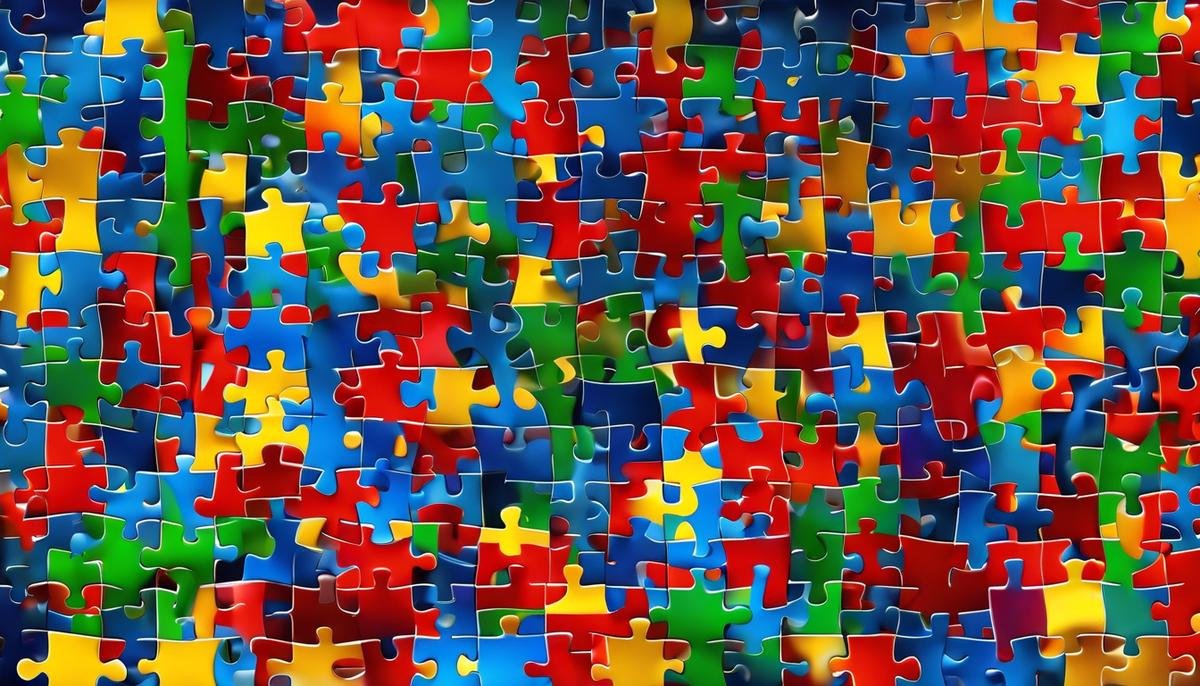
Amidst the myriad of idiosyncrasies that define our individual identity, those associated with Autism Spectrum Disorder (ASD) are often misunderstood. ASD, a neurodevelopmental disorder typified by challenges in social interactions, communication, and certain repetitive behaviors, shapes the existence of many individuals. The world as experienced by those navigating the landscape of autism is unique and often underscored by a reliance on ritualistic regularities or routines. These routines, sometimes seen as mere repetition, actually serve as pivotal elements in managing what can often be an overwhelming sensory and emotional milieu. This rather overlooked aspect of autism needs to be understood, respected, and incorporated within conversations about inclusivity.
Understanding autism spectrum disorder
Understanding Autism Spectrum Disorder and Its Implications
In the beautiful patchwork quilt that is humanity, each person holds a unique place that’s characterized by their particular blend of traits, talents, and challenges. One such specially-crafted piece in this quilt is an individual diagnosed with Autism Spectrum Disorder (ASD). Understanding what ASD is, and how it affects individuals is fundamental. This awareness fosters empathy, promotes inclusivity, and helps create a nurturing environment for everyone involved.
Autism Spectrum Disorder is a broad term encompassing a group of brain development disorders that can manifest myriad forms and severity levels. A development disorder implies that symptoms generally arise in the early developmental stages, many times observed as early as two years of age. However, every individual with ASD is unique; thus, the disorder ranges from mild to severe, expressing itself differently in each person.
What makes Autism Spectrum a “spectrum” disorder is the vast range of possible symptoms. A few common ones to note may include difficulty in social interaction, verbal and non-verbal communication challenges, repetitive behaviors, and unusual responses to sensory input. Remember though, the way these signs present themselves will be unique to each individual – no two people with ASD will share the exact same experiences.
The social interactions of those with autism often differ from what we may generally expect. Individuals could struggle to understand others’ emotions, find maintaining eye contact challenging, or have difficulty developing and sustaining friendships. Such complexities often lead to misinterpreted behaviors or even feelings of isolation.
Language and communication often pose significant challenges for those on the spectrum. They may have delayed speech development or might not speak at all. Some individuals develop a peculiar speech pattern or have a specific, sometimes formal, way of speaking. Non-verbal communication, like body language, can also be puzzling for them.
Routine is comforting for most of us, but for an individual with ASD, it can be absolutely crucial. Many individuals find comfort in having a predictable daily routine and may become agitated by disruptions or changes in that routine.
Looking at the unique response to sensory input, some people with autism might be overly sensitive to sound, light, touch, taste, or smell, while others may be under-responsive. This could explain the preference for specific foods or the aversion to certain textures or sounds.
It is essential to realize that these challenges do not define a person with ASD. They are merely part of their uniqueness. These individuals carry within themselves a wealth of talents, capabilities, and qualities that outshine their difficulties. Their perspective and experiences can provide fresh insights, stimulate personal growth and understanding for all who encounter them. With the right support, understanding, and encouragement, they can thrive, contribute, and enjoy life as much as any other individual.
Comprehending these intricacies of Autism Spectrum Disorder can shape our approach towards those diagnosed with it. With a mix of understanding and empathy, we can create a world that values, welcomes, and cherishes the captivating diversity of humanity.

Ritualistic behaviors in autism: An overview
Recognizing and Understanding Ritualistic Behaviors in Autistic Individuals.
Autism Spectrum Disorder (ASD) is a fascinating and unique aspect of human diversity. Each individual on the spectrum offers a unique perspective on life, portraying both challenges and strengths. One of the most interesting features of ASD is ritualistic behavior—a tendency characterized by a need for routine, sameness, and order, which can greatly aid in understanding the world and identifying potential challenges or comfort zones for individuals with ASD.
Ritualistic behaviors are habits or routines that a person will perform in a specific, repetitive manner. For autistic individuals, these rituals can become particularly pronounced and serve as an essential self-comforting tool. They can manifest in a variety of ways; perhaps it’s arranging toys in a specific manner every time, or following a morning routine exactly the same each day.
Many autistic people have a profound ability to focus and practice immense attention to detail. However, it’s essential to remember these traits are not inherently negative or limiting. In fact, they can lead to exceptional abilities, such as superior memory recall and a unique approach to problem-solving.
So why do autistic individuals engage in these ritualistic behaviors? There are a few widely accepted theories. One suggests these behaviors provide a sense of order and predictability, helping to manage anxiety in a world that can often seem unpredictable and overwhelming. Another posits that engaging in rituals can help to mitigate sensory sensitivities—an autistic person might rock back and forth, for instance, to self-soothe during moments of sensory overwhelm.
Some other common ritualistic behaviors include adherence to specific mealtime rituals, intense fascination with a particular object or topic, repetitive body movements, or creating complex, detailed schedules for routine daily activities.
It’s essential to regard these behaviors with understanding and compassion rather than force change. Abrupt changes can cause considerable distress and discomfort for individuals with ASD. However, this does not mean that these behaviors cannot be guided or adjusted gently when they interfere with the individual’s health, safety, or quality of life.
For parents, caregivers, and anyone interacting with an autistic individual, it’s crucial to remember the value and necessity of these rituals. Viewing these behaviors as an entry point rather than a barrier can help foster positive relationships and enhance understanding.
Above all, patience, respect, and kindness should inform our interactions with individuals with ASD. Their unique ways of viewing the world and distinct behaviors, such as rituals, enrich our communities and teach us invaluable lessons about human diversity and empathy. After all, whether on the autism spectrum or not, each one of us has different quirks and idiosyncrasies. Recognizing and embracing this diversity in habits, interests, and behaviors is central to a compassionate and inclusive society.

Managing ritualistic behaviors: Strategies for parents
Navigating Ritualistic Behaviors in Children with Autism Spectrum Disorder
Step into the heart of any family and it’s bound to be wonderfully unique and beautifully diverse. As a community passionate about parenting and family lifestyle, it’s essential to extend that diversity to understanding behaviors often associated with Autism Spectrum Disorder (ASD) – ritualistic behaviors. These behaviors can be perplexing, and at times challenging, but can also provide a unique insight into the remarkable minds of autistic children.
Ritualistic behaviors can manifest in several ways, ranging from repetitive physical movements to rigid adherence to rules or routines. An autistic child might obsessively arrange their toys in a specific order, seek out certain textures, or insist on eating the same food every day at exactly the same time. These behavioral patterns are sometimes referred to as ‘stimming’, which is a self-soothing strategy for managing over- or under-stimulation. While these behaviors might initially seem odd, they offer comfort, familiarity, and maintain a sense of order in an often chaotic world.
The underlying reasons for ritualistic behaviors may differ. Some theories propose they could serve as a coping mechanism to manage stress. On the other hand, other theories posit that they might be a result of the child’s heightened sensitivity to sensory stimulation. But whatever the reason, it’s crucial to acknowledge these behaviors as an integral part of an autistic child’s identity and life.
Interacting with and supporting a child exhibiting ritualistic behaviors requires a profound understanding and heaps of compassion. And patience, tons of patience. Sometimes, extinguishing a ritualistic behavior may seem like the obvious answer. However, altering these routines can lead to heightened anxiety and stress for the autistic child. Rather than trying to change the behavior, a more effective approach would be to gently guide and shape it over time.
For instance, consider an autistic child who relies on a certain fixed sequence of activities after coming home from school, and becomes distressed if the sequence is disrupted. Instead of entirely eliminating the routine, gradually introducing small changes might be less overwhelming and more successful.
Patience and kindness are invaluable in comprehending the world of autism spectrum disorder. When these behaviors are understood not as limitations, but as distinctive abilities, it fosters a sense of respect and conscientiousness. Each child brings their colors to the canvas of life, and autistic children are no different. Their ritualistic behaviors should be seen as a part of their unique color pallet, enriching the spectrum of human diversity.
In all honesty, managing the ritualistic behaviors of an autistic child can be challenging, even overwhelming. But knowing that these behaviors are not signs of defiance, but comforting mechanisms, can shift perceptions. Add a splash of understanding, a dash of patience, and a generous helping of kindness, and you’ve got a recipe for accepting and celebrating these unique behaviors.
Engaging with this perspective, one realizes that inclusiveness is not just about accepting differences, but appreciating and valuing them too. The kaleidoscopic canvas of life is incomplete without its diverse spectrum of colors. Each with its rituals and behaviors, quirks and qualities, that make it unique. So, let’s celebrate this diversity and build a compassionate and inclusive community, where every child, including those on the autism spectrum, is embraced, cherished, and understood.

Ritualistic behaviors and social life: Tips to build understanding
Raising and interacting with a child with Autism Spectrum Disorder (ASD) is a journey filled with ever-learning experiences. As we move forward in acknowledging and understanding the vast spectrum of autism, it’s essential to understand one core aspect – ritualistic behaviors. This isn’t about defining or pigeon-holing a person with ASD but about embracing their uniqueness and helping them navigate the world in the way that makes the most sense to them.
Ritualistic behaviors are a form of repetition or routine. These could be anything ranging from repeated hand movements, constant foot tapping, or a strict adherence to daily routines or specific patterns. These may seem confusing or meaningless to people without an understanding of ASD but for individuals with autism, these rituals often serve important purposes. They can provide comfort, reduce anxiety, and help to make the world seem more predictable.
The reasons behind ritualistic behaviors are as diverse as the individuals with autism themselves. Some theories suggest that these behaviors could be a form of self-stimulation, or what is known in the autism community as ‘stimming.’ Stimming can be a comforting way for people with ASD to manage their sensory experiences, or a method to express emotions that they may otherwise struggle to articulate.
Understanding and acceptance are the first steps in supporting individuals with autism and their ritualistic behaviors. This requires acknowledging the value that these rituals have in their lives, rather than viewing them as odd or misplaced. It means refraining from attempts to ‘fix them’. Instead, it’s about giving them space to perform these rituals while ensuring they aren’t harmful.
Providing support can vary based on the person and their specific behaviors. For some, it could mean creating a safe space in the home where they can practice their rituals undisturbed. For others, it could be about incorporating these rituals into daily routines or finding ways to adapt them to different environments. Flexibility and communication are key – trying to rigidly control or remove rituals can lead to increased distress and anxiety. Instead, it’s useful to work with the individual in understanding and adapting the rituals so that they feel heard and respected.
One of the most significant things we can do as family, friends, and community members is to shift our perspective on behaviors associated with ASD. This process isn’t easy and it’s human nature to fear or feel uncomfortable with those things we don’t understand. Yet, if we replace fear with curiosity, we often find that it leads to greater understanding, compassion, and acceptance. Small changes in perceptions and shared conversations about inclusivity can have ripple effects, fostering wider acceptance both at home and in the community.
Lastl;y, remember always to be patient and kind. Navigating an autism diagnosis and the many unique paths it may carve in a person’s life can be challenging. Progress doesn’t necessarily look the same for everyone, and what may appear to be a small step for one person can be a huge leap for someone with autism.
We are all learners in this journey, and by understanding the importance of ritualistic behaviors in autism, we can ensure that individuals with ASD feel loved, accepted, and understood in their closest circles and beyond. We are a diverse, robust community bound by compassion – let’s extend these sensibilities to understand and accommodate others’ wonderful uniqueness better.

Moving towards an inclusive society involves nurturing our understanding about the idiosyncrasies of different individuals, in which acknowledging and working with the ritualistic behaviors of those with ASD is a significant step. Fostering empathy and patience is critical, as is creating environments that are not just accepting, but adaptive to autistic individuals. By involving schools, community programs, and every sphere of social life, we can turn our communities into empowering spaces for those living with autism. Building a bridge of understanding between typical behavioral norms and those exhibited by individuals with autism doesn’t just create an inclusive society, it enlightens us all to the vastly varied dimensions of the human experience.




